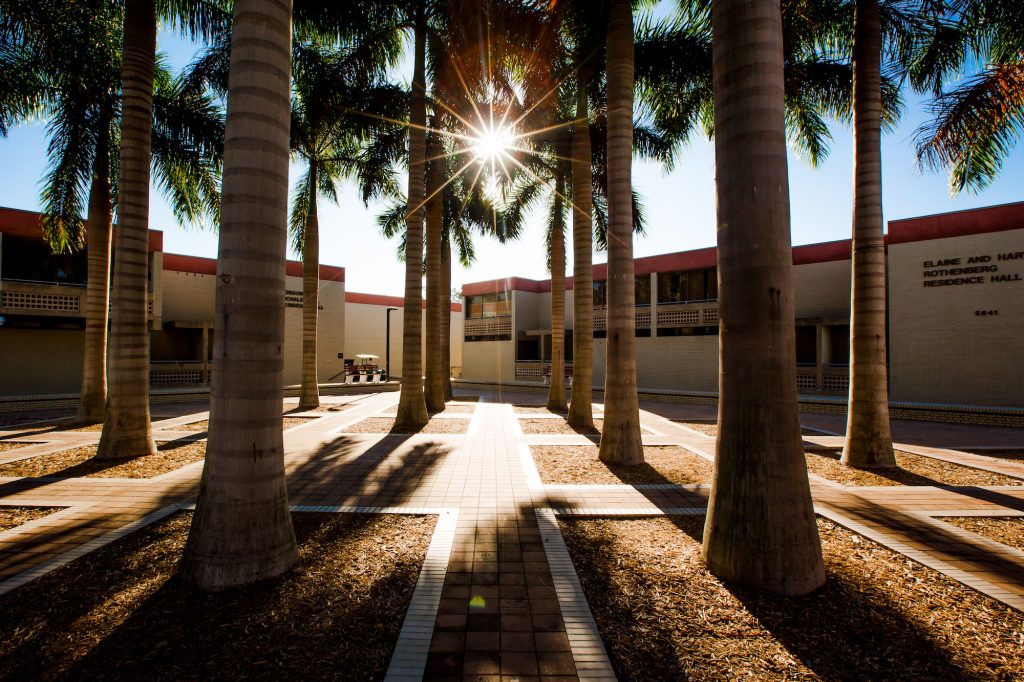Most first-year students live in the Pei Residential Complex, designed by the renowned architect I.M. Pei in the 1960s.
When I.M. Pei first arrived on New College’s Bayfront Campus in early 1963, he was one among nine nationally known architects competing for a $15 million commission to develop a master plan for the fledgling but ambitious college. The architects had been invited to visit New College to participate in a unique two-day collective interview process in which they presented their design ideas to their potential patrons—in the presence of their peers. The postwar college construction boom offered attractive opportunities for the nation’s leading architects as campuses scrambled to physically accommodate increasing numbers of students.
Images courtesy of New College Archives and the Philip Hiss family.
The founders of New College were looking for an architect who had the vision and expertise to create an entire campus from scratch. Pei was known for his stylistic, modern eclecticism, and he also had experience designing airport buildings as well as educational institutions. These were not insignificant skills since the land secured for the New College campus was adjacent to Sarasota’s airport. At the time, Pei’s projects included the National Airlines Terminal at Idlewild (now JFK airport, 1960–70), the National Center for Atmospheric Research in Colorado (1961–66), control towers for the Federal Aviation Administration (1962–72), and the Wilmington Tower in Delaware (1963–71).
New College’s Architect Selection Committee unanimously selected Pei later in 1963. As befitting the distinctive nature of New College, the concept Pei came up with was unique. The Pei residences were designed as a sort of Mediterranean village; three pavilions with interior courts containing small fountains and plantings were clustered around a central plaza. The Brutalist-style buildings were constructed in light gray brick, with each study-bedroom unit designed for two students and opening onto a secluded patio or balcony. A geometrically precise planting of palm trees shaded the large courtyard and provided a collective meeting space.
In 2012, the Florida Association of the American Institute of Architects designated the New College resident halls, student union and Academic Center as one of Florida’s Top 100 Buildings. In its 2018 survey of Florida’s mid-20th century modern architecture, the University of Florida’s Historic Preservation Program selected the Pei residence halls as one of seven educational properties to be included among 50 flagship structures in the state and recommended they be considered for landmark designation.
Today, the three buildings are formally named Gordon E. Michalson Hall, Peggy Bates Hall, and Elaine & Harvey Rothenberg Hall but are often simply referred to as Pei 1st Court, 2nd Court, and 3rd Court. The Pei residence halls accommodate more than 250 current students in double- and triple-occupancy rooms. The outdoor Palm Court situated at the center of the maze-like complex continues to serve as the heart of campus social life, as it has for generations of New College students. The East Campus, also known as the Pei Campus, also houses the Pei-designed Hamilton Center and Hamilton classroom building.
While Pei was working on the New College commission from his firm’s headquarters in New York, he was personally selected by Jacqueline Kennedy to design the John F. Kennedy Library and Museum in Massachusetts. Less than two decades later, Pei had received wide acclaim for the East Building of the National Gallery of Art in Washington, D.C., and embarked on arguably the greatest achievement of his illustrious career, the Grand Louvre Project in Paris.

Timeline of I.M. Pei and Development of New College’s East Campus
1917
Ieoh Ming Pei born on April 26 in Canton (Guangzhou), China, the son of a prominent banker; the family soon moves to Hong Kong and later to Shanghai.
1935
Pei arrives in the United States to attend the University of Pennsylvania; its emphasis on Beaux-Arts tradition and drawing leads Pei to transfer to the Massachusetts Institute of Technology.
1940
Pei receives a bachelor’s degree in architecture from the Massachusetts Institute of Technology.
1942
Marries the former Eileen Loo, a graduate of Wellesley College and a fellow Chinese national whom he had met shortly after his arrival to the United States.
Enrolls in Graduate School of Design at Harvard University, studying alongside Philip Johnson and Paul Rudolph under the tutelage of Walter Gropius and Marcel Breuer.
1943
Suspends his studies at Harvard to serve on the National Defense Research Committee in Princeton during the war.
1945
Returns to Harvard to resume his studies and accepts a teaching position as an assistant professor of design.
1946
Pei receives a master’s degree in architecture from Harvard Graduate School of Design.
1948
Joins Webb & Knapp, William Zeckendorf’s New York real estate development firm, as head of the architectural division.
1955
With Eason Leonard and Henry Cobb, establishes I.M. Pei & Associates as an independent firm.
1960
New College founded as a private liberal arts college in cooperation with the United Church Board for Homeland Ministries (Congregational); Philip Hiss becomes chair of its board of trustees.
1961
A campus site is identified on 115 acres of waterfront property between the cities of Sarasota and Bradenton on Florida’s west coast.
George Baughman is named the first president of New College. Press conference in New York announcing the founding of college and naming of president attracts national attention. Time magazine devotes its education section to the announcement and refers to college as “Ivy League among the Spanish moss.”
Pei unanimously selected as architect of the National Center for Atmospheric Research in Boulder, Colorado.
1962
At the campus dedication ceremony on November 18, earth from Harvard is mixed with soil from New College to symbolize the shared Congregationalist origins and high academic ideals of the two institutions.
1963
Educational Facilities Laboratories, an arm of the Ford Foundation, provides a grant to New College to help fund the interview process for the selection of campus architect.
Nine nationally recognized architects and architectural firms invited to participate in competition to develop campus design for New College. These include Walter Gropius’ firm The Architects Collaborative, John M. Johansen, Louis I. Kahn, Ernest J. Kump, I.M. Pei, John Lyon Reid, Eero Saarinen Associates founded by the late Eero Saarinen, John Carl Warneke, and Harry Weese. Among the contenders’ previous commissions are academic buildings at Cornell, Reed, the University of California at Santa Cruz, Stanford, Yale, the University of Wisconsin, and the University of Pennsylvania.
Architect Selection Committee unanimously selects I.M. Pei; an announcement is made on September 23 in College Hall with leading dignitaries in attendance.
Pei agrees to build “temporary” undergraduate facilities on the property east of U.S. 41 while the West Campus is being designed and constructed; the East Campus buildings would then become a continuing education and conference center.
1964
A public presentation of Pei’s models for the East Campus attracts prominent community members.
Ground broken for East Campus residence complex on July 21; construction of Pei dormitories begins. Congratulatory messages received from President Lyndon B. Johnson and Florida Governor Farris Bryant.
Noted architect Bert Brosmith serves as the architect on site. Brosmith had studied under Louis Kahn at the University of Pennsylvania and worked in Paul Rudolph’s office in Sarasota before opening his own practice in 1960.
New College welcomes its first class; comprised of 101 students, they are housed in the Landmark Hotel on Lido Key as dormitories are not yet complete.
Jacqueline Kennedy selects Pei to be the architect of the John F. Kennedy Library and Museum; it is completed in 1979.
1965
New College trustees authorize Pei to begin designing the master plan for the West Campus.
From late March, students begin moving into East Campus residences as rooms are gradually completed. They are delighted with the private entrances and bathrooms, air-conditioning, and courtyard jasmine and gardenia plantings and fountains.
Administration and faculty in turmoil and fundraising efforts insufficient. George Baughman leaves the presidency of New College to become the founding president of the newly established New College Foundation.
John Elmendorf becomes the second president of New College.
Carl Abbott recruited to work in Pei’s office in New York City and assists with the design process of the second phase. After graduating with a degree in architecture from the University of Florida in 1959, Abbott had worked with Bert Brosmith in Sarasota and then went on to earn a Master of Architecture at Yale University in 1962, where he studied under Paul Rudolph. Abbott later achieves renown for his independent design work as the youngest member of the Sarasota School of Architecture.
1966
Groundbreaking and beginning of two phases of Pei-designed New College East Campus, to be known as Carl and Marjorie Hamilton Court, or Hamilton Court; the complex comprises a student activities building, a dining room to seat 350, a snack bar, a fully equipped kitchen, a reception center, and private dining or meeting rooms. Adjoining building to have a teaching auditorium, a language laboratory, and classrooms.
Pei sends a Western Union telegram to President John Elmendorf: “SINCERELY REGRET NOT BEING ABLE TO JOIN YOU ON THIS HAPPY OCCASION BUT SEND MY VERY BEST WISHES AS YOU BREAK GROUND FOR THE ‘HAMILTON’ COURT GROUP=I M PEI=”
Mesa Laboratory of National Center for Atmospheric Research completed.
Pei’s firm renamed I.M. Pei & Partners.
1967
Dedication of Carl and Marjorie Hamilton Center, East Campus, on May 4.
Mesa Laboratory of National Center for Atmospheric Research dedicated on May 10.
Hamilton Center Auditorium and Classroom Building constructed.
New College’s “Charter Class” of 1964 graduates.
Pei formally resigns from the New College project due to financial considerations and disputes over architectural design.
1975
New College joins the State University System of Florida as part of the University of South Florida.
1978
Pei-designed East Building of National Gallery of Art in Washington, D.C., completed.
1979
I.M. Pei receives the Gold Medal of the American Institute of Architects, its highest honor.
1983
I.M. Pei awarded The Pritzker Architecture Prize, widely considered the Nobel Prize of architecture.
Harry Sudakoff Lecture and Conference Center opens on New College’s Pei Campus.
1989
Pei-designed Louvre Pyramid completed.
1990
A new fitness center is constructed on New College’s Pei Campus.
1995
Pei-designed Rock & Roll Hall of Fame and Museum in Cleveland completed.
2001
New College achieves independence as the 11th member of the State University System of Florida and is designated by the Florida Legislature as the Honors College for the State of Florida.
2008
Palm Court is restored with new palm trees and commemorative bricks and pavers.
2010
Pei-designed Hamilton Student Center is renovated, to include a lobby and new Black Box Theater.
2019
I.M. Pei dies on May 16 at the age of 102.
Additional Resources
Arthur, Furman C. New College: The First Three Decades. Sarasota: New College Foundation, 1995.
Howey, John. The Sarasota School of Architecture, 1941–1966. Cambridge: MIT Press, 1995.
Jodidio, Philip. I.M. Pei: The Complete Works. New York: Rizzoli, 2008.
“I.M. Pei: Building China Modern.” Anne Makepeace, Director. American Masters Film, 2010.
I.M. Pei Papers, 1920-2016, Library of Congress.
Reid, Aileen. I.M. Pei. New York: Crescent Books, 1995.
Von Boehm, Gero. Conversations with I.M. Pei: Light is the Key. Munich: Prestel Verlag, 2000.
Wiseman, Carter. I.M. Pei: A Profile in American Architecture. New York: H.N. Abrams, 1990.

